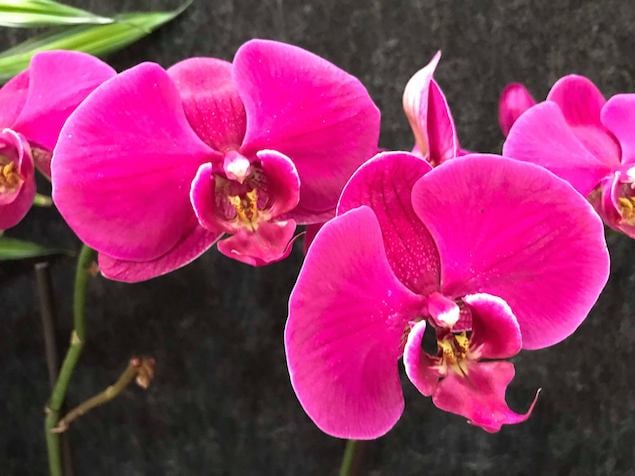
If you’ve been waiting patiently for your orchid to rebloom and have been diligent in providing your orchid with adequate light, water and fertilizer and nothing is happening, the problem could be insects. Insect pests can interfere with orchid reblooming. It’s a good idea to inspect your orchid for signs of insects every week when you water your Just Add Ice Orchid with three ice cubes. Taking immediate action to treat problems as soon as they occur will help your Phalaenopsis orchid return to good health.
Spider mites, mealy bugs and scale insects are the most common pests that interfere with orchid reblooming. They feed on plant juices and will eventually kill your orchid if left untreated. Control these insects by spraying your orchid with a light spray of horticultural oil or insecticidal soap diluted with water.
Spider mites  favor dry conditions. Maintaining adequate humidity in the room where your orchids are displayed is the best way to avoid these pests. Greenish-yellow in color, spider mites and their tiny webs may be observed on the undersides of leaves of affected plants. If yellow spots appear on the leaves of your orchid, suspect spider mites. Eventually, feeding mites will cause the entire leaf to turn yellow and drop off.
favor dry conditions. Maintaining adequate humidity in the room where your orchids are displayed is the best way to avoid these pests. Greenish-yellow in color, spider mites and their tiny webs may be observed on the undersides of leaves of affected plants. If yellow spots appear on the leaves of your orchid, suspect spider mites. Eventually, feeding mites will cause the entire leaf to turn yellow and drop off.
Mealy bugs  have tiny, oval, whitish bodies with two to four protruding filaments. Mealy bug activity can be identified by what looks like tiny tufts of cotton on the leaves of orchid plants. Mealy bugs also produce copious amount of a sticky sweet substance called honeydew, which can give plant leaves a tacky feel.
have tiny, oval, whitish bodies with two to four protruding filaments. Mealy bug activity can be identified by what looks like tiny tufts of cotton on the leaves of orchid plants. Mealy bugs also produce copious amount of a sticky sweet substance called honeydew, which can give plant leaves a tacky feel.
 Scale Insects are another mite-sized orchid invader. If you notice small white bumps along the leaves and flower spikes of your orchid, scale is present. Major honeydew producers, scale can also leave a sticky residue on orchid leaves.
Scale Insects are another mite-sized orchid invader. If you notice small white bumps along the leaves and flower spikes of your orchid, scale is present. Major honeydew producers, scale can also leave a sticky residue on orchid leaves. Phalaenopsis orchids typically bloom for about three months before entering a nine-month resting period known as dormancy. When your orchid is dormant, it's storing up the nutrients it needs to continue growing. Most orchids rebloom on their own, but sometimes they need a little coaxing.
Follow these three simple steps to trigger orchid reblooming:
Orchid reblooming may take a little coaxing, and you might have to run some interference to keep common pests from interfering. But reblooming is a natural part of the orchid lifecycle, and it's rewarding to see those blooms come back!
For more tips, check out our handy orchid reblooming guide.
Photo credits: agrilifetoday, DanCentury and theloushe

Copyright Just Add Ice® Orchids 2023